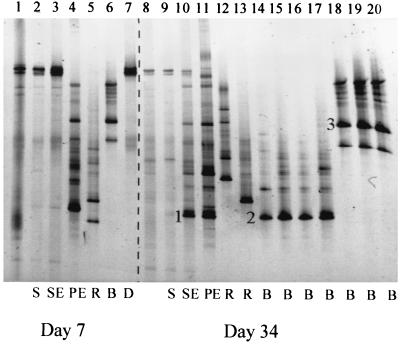FIG. 4.
Comparison of the DGGE patterns of soil DNA of the B-horizon soil with 2,4-D, with or without the donor P. putida UWC3 (pEMT1::lacZ) (soil DNA), and with DNAs of a mixture of colonies resuspended from transconjugant selective plates (plate DNA) and of single colonies of purified and confirmed transconjugants on days 7 and 34. Bands 1 and 2 are very similar, and their sequences are most related to B. graminis (96%). The sequence of band 3 matched most closely Burkholderia caribensis (96.6%). Lanes 1 and 8, native B-horizon soil without 2,4-D or the donor at days 0 and 89, respectively; lanes 2 and 9, soil DNA from noninoculated B-horizon soil plus 2,4-D on days 7 and 34, respectively (S); lanes 3 and 10, soil DNA from B-horizon soil plus 2,4-D plus pEMT1::lacZ on days 7 and 34, respectively (SE); lanes 4 and 11, plate DNA from transconjugant-selective plates on days 7 and 34, respectively (PE); lanes 5, 6, and 12 through 20, single colonies of purified transconjugants on days 7 and 34, respectively (B, Burkholderia species; R, R. eutropha-like organism); lane 7, P. putida UWC3 (pEMT1::lacZ) (D).

